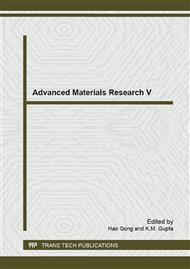p.237
p.245
p.253
p.259
p.264
p.269
p.274
p.280
p.285
Interfacial and Demulsification Properties of Janus Type Magnetic Nanoparticles
Abstract:
Water-in-oil emulsions are formed during crude oil production. Some natural surfactants (asphaltenes) aggregates are known to form viscoelastic film preventing coalescence of emulsified water droplets. The present research work investigates the interfacial properties and demulsifying capacity of Janus type magnetic nanoparticles. poly (methylmethacrylate-acrylicacid-divinylbenzene) iron oxide Janus nanoparticles with Interfacially active P(MMA-AA-DVB) block copolymer and iron oxide (magnetic) shows excellent interfacial and magnetic properties. Experiments performed at the oil-water interface indicates that Janus particles adsorb at the oil - water interface and separate the emulsified water from the external magnetic field. The external magnetic play important role demulsification of magnetically tagged emulsified water droplets, producing smaller volumes of sludge and decrease the hydrocarbon loss to waste aqueous phase. The chemical bonding of interfacially active P(MMA-AA-DVB) grafted with magnetic nanoparticles and the magnetic property of P(MMA-AA-DVB)/Fe3O4 allowed the used Janus nanoparticles to be readily recycled by magnetic separation and regenerated by solvent washing.
Info:
Periodical:
Pages:
264-268
Citation:
Online since:
May 2015
Authors:
Price:
Сopyright:
© 2015 Trans Tech Publications Ltd. All Rights Reserved
Share:
Citation:


